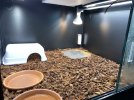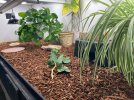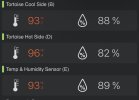PrinceH4H4T4
New Member
How is my setup so far? I do plan on adding some potted live plants (Boston fern or spider plants) just to add some extra shade. Other wise here’s what I’ve got so far. All tips are welcome. Just want to make sure everything is perfect as can be, before I bring a Burmese home.
The daytime heat is supplied above the slate by a 45w incandescent flood bulb (12hour cycle). Surface temps of the rock is ~105°F and the shell height probe temp is ~ 98°F.
Ambient temperature and humidity are tracked by 3 acurite outdoor sensors. One near the hot spot, one in the opposite corner (cool side near food and water dish). And a temporary one under the hide. They are currently reading:
Daytime (peak temperatures w/ corresponding humidity at that temperature)
Nighttime (lowest temperature w/corresponding humidity at that temperature)
The enclosure itself is 3’x3’x2’ and filled with 4-5” of Reptichip (compressed coconut chips) and topped with orchard bark.
There is an Arcadia t5ho uvb bulb running along the right side of the enclosure. Which gives me UVI (taken with solar meter 6.5) of 2.5-3.5 directly under it and drops to 0 on the other side of the enclosure. This is also on a 12 hour cycle. And there are some 6500k LED bars for ambient light/plant growth.
I think my only real concern is that the cool side gets up to 93°. Not sure if that is too hot for a little guy.
All tips/tricks/advice is very welcome!
Thanks in advance!
@Tom
The daytime heat is supplied above the slate by a 45w incandescent flood bulb (12hour cycle). Surface temps of the rock is ~105°F and the shell height probe temp is ~ 98°F.
Ambient temperature and humidity are tracked by 3 acurite outdoor sensors. One near the hot spot, one in the opposite corner (cool side near food and water dish). And a temporary one under the hide. They are currently reading:
Daytime (peak temperatures w/ corresponding humidity at that temperature)
- Hot side: 97°F and 79% humidity
- Cool side: 93°F and 90% humidity
- Hide box: 89°F and 85% humidity
Nighttime (lowest temperature w/corresponding humidity at that temperature)
- Hot side: 79°F and 89% humidity
- Cool side: 79°F and 91% humidity
- Hide box: 80°F and 88% humidity
The enclosure itself is 3’x3’x2’ and filled with 4-5” of Reptichip (compressed coconut chips) and topped with orchard bark.
There is an Arcadia t5ho uvb bulb running along the right side of the enclosure. Which gives me UVI (taken with solar meter 6.5) of 2.5-3.5 directly under it and drops to 0 on the other side of the enclosure. This is also on a 12 hour cycle. And there are some 6500k LED bars for ambient light/plant growth.
I think my only real concern is that the cool side gets up to 93°. Not sure if that is too hot for a little guy.
All tips/tricks/advice is very welcome!
Thanks in advance!
@Tom
Attachments
Last edited:



